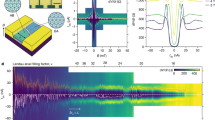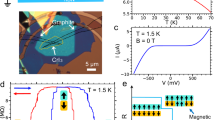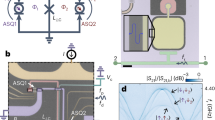Abstract
Progress in the fabrication of nanometre-scale electronic devices is opening new opportunities to uncover deeper aspects of the Kondo effect1—a characteristic phenomenon in the physics of strongly correlated electrons. Artificial single-impurity Kondo systems have been realized in various nanostructures, including semiconductor quantum dots2,3,4, carbon nanotubes5,6 and individual molecules7,8. The Kondo effect is usually regarded as a spin-related phenomenon, namely the coherent exchange of the spin between a localized state and a Fermi sea of delocalized electrons. In principle, however, the role of the spin could be replaced by other degrees of freedom, such as an orbital quantum number9,10. Here we show that the unique electronic structure of carbon nanotubes enables the observation of a purely orbital Kondo effect. We use a magnetic field to tune spin-polarized states into orbital degeneracy and conclude that the orbital quantum number is conserved during tunnelling. When orbital and spin degeneracies are present simultaneously, we observe a strongly enhanced Kondo effect, with a multiple splitting of the Kondo resonance at finite field and predicted to obey a so-called SU(4) symmetry.
This is a preview of subscription content, access via your institution
Access options
Subscribe to this journal
Receive 51 print issues and online access
$199.00 per year
only $3.90 per issue
Buy this article
- Purchase on Springer Link
- Instant access to full article PDF
Prices may be subject to local taxes which are calculated during checkout



Similar content being viewed by others
References
Hewson, A. C. The Kondo Problem to Heavy Fermions (Cambridge Univ. Press, Cambridge, 1993)
Goldhaber-Gordon, D. et al. Kondo effect in a single-electron transistor. Nature 391, 156–159 (1998)
Cronenwett, S. M., Oosterkamp, T. H. & Kouwenhoven, L. P. A tunable Kondo effect in quantum dots. Science 281, 540–544 (1998)
Schmid, J., Weis, J., Eberl, K. & von Klitzing, K. A quantum dot in the limit of strong coupling to reservoirs. Physica B 256–258, 182–185 (1998)
Nygård, J., Cobden, D. H. & Lindelof, P. E. Kondo physics in carbon nanotubes. Nature 408, 342–346 (2000)
Buitelaar, M. R., Bachtold, A., Nussbaumer, T., Iqbal, M. & Schönenberger, C. Multi-wall carbon nanotubes as quantum dots. Phys. Rev. Lett. 88, 156801 (2002)
Park, J. et al. Coulomb blockade and the Kondo effect in single-atom transistors. Nature 417, 722–725 (2002)
Liang, W., Shores, M. P., Bockrath, M., Long, J. R. & Park, H. Kondo resonance in a single-molecule transistor. Nature 417, 725–729 (2002)
Cox, D. L. & Zawadowski, A. Exotic Kondo effects in metals: magnetic ions in a crystalline electric field and tunnelling centers. Adv. Phys. 47, 599–942 (1998)
Kolesnychenko, O. Yu., de Kort, R., Katsnelson, M. I., Lichtenstein, A. I. & van Kempen, H. Real-space imaging of an orbital Kondo resonance on the Cr(001) surface. Nature 415, 507–509 (2002)
Inoshita, T., Shimizu, A., Kuramoto, Y. & Sakaki, H. Correlated electron transport through a quantum dot: the multiple-level effect. Phys. Rev. B 48, 14725–14728 (1993)
Borda, L., Zaránd, G., Hofstetter, W., Halperin, B. I. & von Delft, J. SU(4) Fermi liquid state and spin filtering in a double quantum dot system. Phys. Rev. Lett. 90, 026602 (2003)
Zaránd, G., Brataas, A. & Goldhaber-Gordon, D. Kondo effect and spin filtering in triangular artificial atoms. Solid State Commun. 126, 463–466 (2003)
López, R. et al. Probing spin and orbital Kondo effects with a mesoscopic interferometer. Preprint available at http://xxx.lanl.gov/abs/cond-mat/0402361.
Sasaki, S., Amaha, S., Asakawa, N., Eto, M. & Tarucha, S. Enhanced Kondo effect via tuned orbital degeneracy in a spin ½ artificial atom. Phys. Rev. Lett. 93, 017205 (2004)
Dresselhaus, M. S., Dresselhaus, G. & Eklund, P. C. Science of Fullerenes and Carbon Nanotubes (Academic, San Diego, 1996)
Minot, E., Yaish, Y., Sazonova, V. & McEuen, P. L. Determination of electron orbital magnetic moments in carbon nanotubes. Nature 428, 536–539 (2004)
Ajiki, H. & Ando, T. Electronic states of carbon nanotubes. J. Phys. Soc. Jpn. 62, 1255–1266 (1993)
Zaric, S. et al. Optical signatures of the Aharonov–Bohm phase in single-walled carbon nanotubes. Science 304, 1129–1131 (2004)
Coskun, U. C., Wei, T.-C., Vishveshwara, S., Goldbart, P. M. & Bezryadin, A. h/e magnetic flux modulation of the energy gap in nanotube quantum dots. Science 304, 1132–1134 (2004)
Jarillo-Herrero, P. et al. Electronic transport spectroscopy of carbon nanotubes in a magnetic field. Preprint available at http://xxx.lanl.gov/cond-mat/0411440.
Liang, W., Bockrath, M. & Park, H. Shell filling and exchange coupling in single-walled carbon nanotubes. Phys. Rev. Lett. 88, 126801 (2002)
De Franceschi, S. et al. Electron cotunneling in a semiconductor quantum dot. Phys. Rev. Lett. 86, 878–881 (2001)
Paaske, J., Rosch, A. & Wölfle, P. Nonequilibrium transport through a Kondo dot in a magnetic field: perturbation theory. Phys. Rev. B 69, 155330 (2004)
Pasupathy, A. N. et al. The Kondo effect in the presence of ferromagnetism. Science 306, 86–89 (2004)
Costi, T. A. Kondo effect in a magnetic field and the magnetoresistivity of Kondo alloys. Phys. Rev. Lett. 85, 1504–1507 (2000)
Sasaki, S. et al. Kondo effect in an integer-spin quantum dot. Nature 405, 764–767 (2000)
Choi, M.-S., López, R. & Aguado, R. SU(4) Kondo effect in carbon nanotubes. Phys. Rev. Lett. (submitted)
Mann, D., Javey, A., Kong, J., Wang, Q. & Dai, H. J. Ballistic transport in metallic nanotubes with reliable Pd ohmic contacts. Nano Lett. 3, 1541–1544 (2003)
Bonet, E., Deshmukh, M. M. & Ralph, D. C. Solving rate equations for electron tunneling via discrete quantum states. Phys. Rev. B 65, 045317 (2002)
Acknowledgements
We thank G. Zaránd, R. Aguado and J. Martinek for discussions. Financial support was obtained from the Japanese Solution Oriented Research for Science and Technology (SORST) program and the Dutch Fundamenteel Onderzoek der Materie (FOM).
Author information
Authors and Affiliations
Corresponding author
Ethics declarations
Competing interests
The authors declare that they have no competing financial interests.
Supplementary information
Supplementary Figure S1
This file contains Supplementary Figure S1, which consists of three panels related to the 'Single particle energy spectrum & G(VG, B) spectroscopy' section of the Supplementary Information. (PDF 106 kb)
Supplementary Figure S2
This file contains Supplementary Figure S2, which details the temperature dependence data for the SU(4) Kondo effect. (PDF 195 kb)
Supplementary Discussion
This file consists of four sections, the orbital degeneracy & Kondo effect; the single particle energy spectrum & G(VG, B) spectroscopy; the temperature dependence; and the fabrication and measurement setup (DOC 41 kb)
Erratum
Erratum regarding incorrect Supplementary Information uploading to Nature's website for this paper. This correction was made on 31 March 2005. (DOC 24 kb)
Rights and permissions
About this article
Cite this article
Jarillo-Herrero, P., Kong, J., van der Zant, H. et al. Orbital Kondo effect in carbon nanotubes. Nature 434, 484–488 (2005). https://doi.org/10.1038/nature03422
Received:
Accepted:
Issue Date:
DOI: https://doi.org/10.1038/nature03422
This article is cited by
-
Clues to potential dipolar-Kondo and RKKY interactions in a polar metal
npj Quantum Materials (2023)
-
Two-impurity Kondo effect in potassium-doped single-layer p-sexiphenyl films
Science China Physics, Mechanics & Astronomy (2022)
-
Evolution and universality of two-stage Kondo effect in single manganese phthalocyanine molecule transistors
Nature Communications (2021)
-
Quantum Noise in Carbon Nanotubes as a Probe of Correlations in the Kondo Regime
Journal of Low Temperature Physics (2020)
-
Charge transport in a polar metal
npj Quantum Materials (2019)
Comments
By submitting a comment you agree to abide by our Terms and Community Guidelines. If you find something abusive or that does not comply with our terms or guidelines please flag it as inappropriate.



